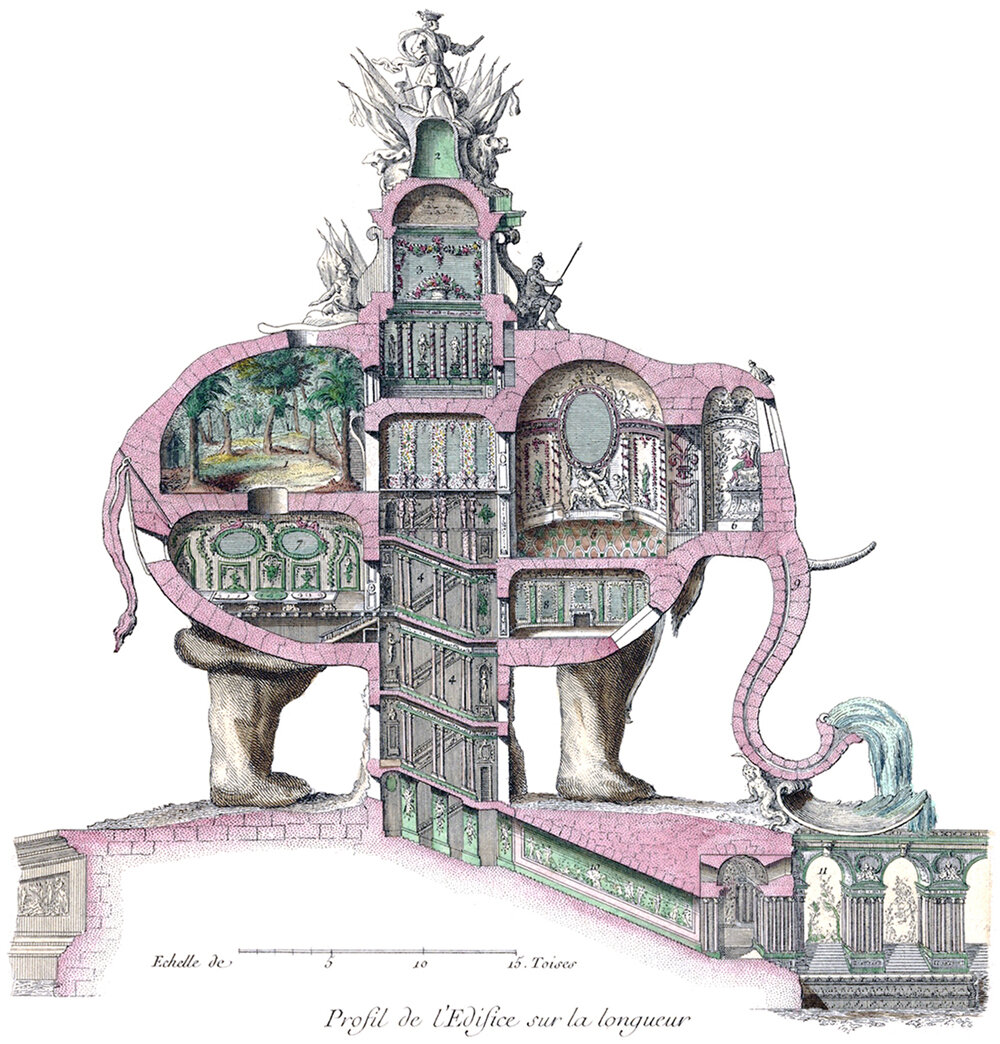Charles Ribart’s Triumphal Elephant
Drawing by Pierre Patte of Charles-François Ribart’s L’Éléphant Triomphal monument, designed in 1758 for the site which would house the Arc de Triomphe in Paris a few decades later.
Certain architectural proposals are hard to take seriously. This is one of them. It’s a design for the site that the Arc de Triomphe would eventually get built on in Paris, and it was proposed a few decades before the iconic monument broke ground. Yes, it’s a giant elephant. Yes, the architect was being serious. Yes, the French government swiftly rejected the proposal.
The L’Éléphant Triomphal, as it was called, was designed by French architect Charles François Ribart in 1758. It was one of many competing proposals for a monument to King Louis XV after the War of the Austrian Succession. As for the design itself, there’s so much to unpack, including the fountain springing from the beast’s trunk, the mostly-unlit indoor garden on the upper left, or the unfortunate placement of a window just under the animal’s tail, but I digress.
Of main importance here is Ribart’s use of verticality. First, he placed the elephant up on a large plinth to signify its importance. This is a common move for monuments and statues, as the ascent required to reach them symbolizes the transition to a different plane, above the surface. Second, Ribart allowed the public to climb up into the sculpture and look out onto their city from above. He accomplished this by inserting a central tower into the building, which cuts through the body and springs forth above the animal’s back, with a statue of Louie XV at the top. The tower effectively renders the elephant a moot point, since on its own, the shaft would’ve made a much more believable proposal, similar to a triumphal column. Had the path to the top been through one of the elephant’s legs, it would’ve been a much less awkward composition.
Side view of Charles-François Ribart’s L’Éléphant Triomphal monument, designed in 1758 for the site which would house the Arc de Triomphe in Paris a few decades later. Drawn by Pierre Patte.
This side view of the monument shows just how awkward the tower element is. It effectively impales the elephant, destroying it’s locomotion abilities. It also diminishes the overall effectiveness of the tower, which is lost through the enormous body of the pachyderm. Normally, a tower like this stands alone, above its surroundings and in contrast to the surface we all exist upon. This one punctures the body of an elephant and awkwardly holds up a statue of King Louie XV.
Floor plans of Charles-François Ribart’s L’Éléphant Triomphal monument, designed in 1758 for the site which would house the Arc de Triomphe in Paris a few decades later. Drawn by Pierre Patte.
When I first saw this project, I was fascinated by the design. The section drawing was the first I saw of it, and it immediately caught my eye. It’s a beautifully rendered image, and the illustrator Pierre Patte really rendered the design in the best possible light. The more I pondered the nature of the monument, however, the less intrigued I became. It’s the exact opposite of my thoughts on Saverio Dioguardi’s Tribune Tower, which gets richer each time I look at it. This one just gets more awkward, even though I still love the section drawing.
Check out other unbuilt designs here.



